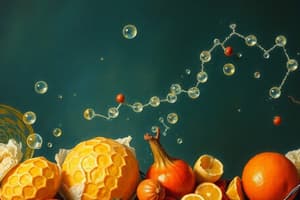Podcast
Questions and Answers
What is a key characteristic that distinguishes polysaccharides from monosaccharides?
What is a key characteristic that distinguishes polysaccharides from monosaccharides?
- Polysaccharides have a smaller particle size.
- Polysaccharides are sweet in taste.
- Polysaccharides are soluble in water.
- Polysaccharides do not pass through a membrane. (correct)
What process describes the formation of glycogen from glucose in the body?
What process describes the formation of glycogen from glucose in the body?
- Glycogenesis (correct)
- Catabolism
- Fermentation
- Lipidogenesis
Which of the following is true about cellulose?
Which of the following is true about cellulose?
- It is a soluble fiber digested easily by humans.
- It is composed mainly of glycosaminoglycans.
- It serves a structural purpose in plants. (correct)
- It contributes to the sweet taste of plant tissues.
What product is formed during the hydrolysis of starch?
What product is formed during the hydrolysis of starch?
What role does glycosaminoglycans serve in the human body?
What role does glycosaminoglycans serve in the human body?
Which polysaccharide is known for being stored energy in plants?
Which polysaccharide is known for being stored energy in plants?
What primarily happens when starch is placed in boiling water?
What primarily happens when starch is placed in boiling water?
What is one function of dextran in the human body?
What is one function of dextran in the human body?
What distinguishes glucose from fructose at a structural level?
What distinguishes glucose from fructose at a structural level?
Which of the following is a common feature of disaccharides?
Which of the following is a common feature of disaccharides?
Which disaccharide is known as milk sugar?
Which disaccharide is known as milk sugar?
What is the primary purpose of hydrolyzing starch in the production of maltose?
What is the primary purpose of hydrolyzing starch in the production of maltose?
Which characteristic of sucrose makes it unlike lactose in terms of fermentation by yeast?
Which characteristic of sucrose makes it unlike lactose in terms of fermentation by yeast?
Which statement accurately describes polysaccharides?
Which statement accurately describes polysaccharides?
What is the normal range for glucose levels in the blood?
What is the normal range for glucose levels in the blood?
What process results in the formation of monosaccharides from disaccharides?
What process results in the formation of monosaccharides from disaccharides?
Why were cyclamates banned in the USA after 1969?
Why were cyclamates banned in the USA after 1969?
Flashcards are hidden until you start studying
Study Notes
Carbohydrates
- Common sugars and starches, produced in plants and used as an energy source by animals.
- Monosaccharides are the simplest form of carbohydrates.
- Disaccharides are formed by combining two monosaccharides.
- Polysaccharides are large polymers formed by many monosaccharides linked together.
Monosaccharides
- Examples include glucose and fructose.
- Glucose is also known as dextrose or blood sugar.
- Galactose is one of the two monosaccharides that form lactose.
Disaccharides
- Typically sweet, white, solid and crystalline.
- Examples include sucrose, maltose, and lactose.
- Sucrose, known as cane sugar, is commonly used for sweetening.
- Maltose, or malt sugar, is found in germinating grains.
- Lactose, or milk sugar, is found in milk and fermented to produce lactic acid.
Polysaccharides
- Polymers of monosaccharides that are tasteless and insoluble in water.
- They are too large to pass through cell membranes.
Types of Polysaccharides
- Starch is a stored form of energy in plants, found in amylopectin and amylose.
- Cellulose provides structural support for plants and is indigestible by humans.
- Glycogen is stored in the liver and muscles, acting as a reserve supply of glucose.
- Dextrin is an intermediate product formed during starch hydrolysis.
- Heparin is an anticoagulant found in the body.
- Dextran is used as a blood extender and can contribute to dental plaque formation.
Carbohydrate Derivatives
- Glycosaminoglycans are a gel-like substance that lubricates connective tissues and joints.
Studying That Suits You
Use AI to generate personalized quizzes and flashcards to suit your learning preferences.




